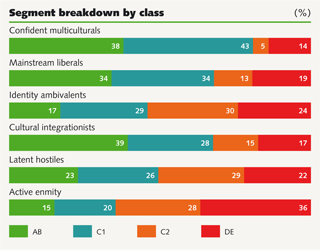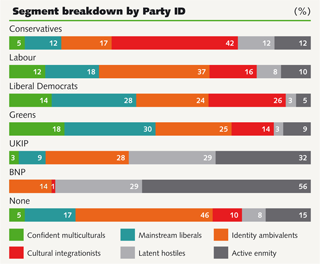Fear and HOPE 2011
The New ‘Tribes’ of British Identity Politics
Confident Multiculturals (eight per cent of the population)
Most likely to be graduates or post graduates, these people are predominantly professionals and managers. They are more prevalent in London and the South East, and among people who identify with Labour, Liberal Democrat and Green. Outgoing, social and happy with their lives, they are confident about their own, as well as their country’s future, and think Britain has benefitted from immigration.
Mainstream Liberals (16%)
These people are optimistic, self-motivated and for the most part educated to at least degree level. They see immigration as a net benefit to the country, and usually differ from Confident Multiculturals only in their level of enthusiasm about it.
Identity Ambivalents (28%)
These people are less financially secure and less optimistic about the future. They are more likely to be working class, to live in social housing and to view immigration through the prism of its economic impact on their opportunities and the social impact on their communities. Muslims and other BME (Black Minority Ethnic) groups are more prevalent here as are the largest single segment of those who identify with Labour.
Culturally Concerned (24%)
Generally older and more prosperous than other groups, many are (or have been) professionals and managers. They are more likely to view immigration as a cultural issue with concerns about the impact of immigration on national identity and about immigrants’ willingness to integrate. This group forms the largest segment of those identifying with the Conservative Party.
Latent Hostiles (10%)
More likely to be older, not university-educated, and more than likely working class. They view their own future with uncertainty and Britain’s future with pessimism. For them, immigration has undermined British culture, public services and their own economic prospects. They would support political forces that stood-up for their identity and way of life, but are less confrontational than those in Active Enmity.
Active Enmity (13%)
Drawing more support from the unskilled and the unemployed, these people are the most disengaged from traditional political processes and the most hostile to immigrants and what they think immigration represents. Opposed to all ethnicities or religions other than their own, many believe that violence is acceptable if it is a consequence of standing up for what is ‘right’. 2

The key point here is that these ‘tribes’ have a relationship with social class. The table right displays the class compositions of each of the ‘tribes’:
According to National Readership Survey, in 2010, 26% of the population were AB, 29% were C1, 21% were C2, and 23% DE.3 Using this baseline data, we can see that Cultural Integrationists, Confident Multiculturals and Mainstream Liberals are significantly more affluent than the average. Identity Ambivalents comprise more C1 and C2s. Active Enmity are more working class.
However, social class does not suffice as a substitute for these categories.
The centreground groups on this identity axis are Identity Ambivalents and Cultural Integrationists. The major differences between them are their class composition and their motivation.
The former are more motivated by economics and perceptions of fairness; the latter are motivated by authority and order, and their political identification.

The following table is a breakdown of ‘tribe’ composition of each party’s vote:
Interestingly, the BNP vote contains almost no Cultural Integrationists. This is largely due to the violent and extreme image of the party, which proves deeply off-putting. However, 28% Cultural Integrationists support UKIP, though its largest block of support comes from Active Enmity (32%). Labour’s biggest single block of support comes from the Identity Ambivalents. Interestingly, that group also forms the largest block of none voters and the third largest block of BNP supporters. In many ways, this group resembles the ‘squeezed middle’ that has attracted so much political attention – it is the new swing group of British politics. It is worth considering this group in isolation.
The Identity Ambivalents as ‘squeezed middle’, swing vote and at risk tribe
The ‘tribes’ that have been identified are unlikely to be static. While the Populus survey is a snapshot, the variation of ‘tribe’ composition over age cohorts varies considerably.
Amongst the 25-34 age group, half (50%) are Identity Ambivalents – but this declines to 13% in the 55-64 age range, and then only eight per cent of the over 65s. Of this latter group, 44% are Cultural Integrationists.
It seems reasonable to hypothesise that people can – and do – shift between these groups in response to life events, as they do with shifting values during the natural course of their life. Of particular interest here are the Identity Ambivalents.
One of the defining features of this group is their tendency to view immigration through the prism of their economic circumstances. Where Cultural Integrationists are focused on order and authority, Identity Ambivalents will be more focused on fairness and their own personal circumstances. And with declining living standards, joblessness, casualisation of labour, and public sector cuts, it is this group that is perhaps more vulnerable to drifting towards Latent Hostility or Active Enmity.
To illustrate this point, 59% of the Identity Ambivalents are C1 or C2. This means that the net annual income of the chief income earner is in the £20,000 region, roughly the median in the UK income scale.4 In many respects, this group has an overlap with what has come to be described by political parties as the ‘squeezed middle.’5
This is a significant ‘at risk’ group, in terms of shifting to the tribes to the right. As they move through life, many may become more concerned about order and authority and so may find themselves becoming more Cultural Integrationist. However, if an adverse economic or social event befalls them they may leap-frog towards Latent Hostility or, in extreme cases, Active Enmity. One caveat is necessary: most Black and Minority Ethnic [BAME] people are Identity Ambivalent. It is likely that this group will be less attracted by more the culturally antagonistic perspectives held by the tribes to the right.
If we look at the socio-demographic profiles of Identity Ambivalents and Latent Hostiles there are some striking similarities.
| AB | C1 | C2 | DE | |
| Identity Ambivalents | 17% | 29% | 30% | 24% |
| Latent Hostiles | 23% | 26% | 29% | 22% |
There are also some differences that should be noted. Latent Hostiles are more likely to be owner-occupiers (71% to 53%.) In terms of housing tenure, Identity Ambivalents bear a resemblance to Active Enmity.
| Owner occupier | Social housing | Private rental | |
| Identity Ambivalents | 53% | 30% | 17% |
| Latent Hostiles | 61% | 27% | 11% |
There is a greater firewall between Cultural Integrationist and Active Enmity ‘tribes’, given the authority and order predisposition of the former. However, the BNP has a 14% Identity Ambivalent vote against nine per cent of UKIP’s vote.
In terms of mainstream party politics, Labour’s ability to communicate with this ‘squeezed middle’ vote of Identity Ambivalents is clearly key to retaining their faith in the efficacy and justice of politics. Only 17% of the Conservative identifiers are Identity Ambivalents. In Labour’s case, it is 37%.
The party identification which contains the largest relative proportion of this group is those with no party identification. They are the swing vote, the ‘squeezed middle’ but also the group most at risk of drifting into Latent Hostility or Active Enmity.
Notes
3. http://www.nrs.co.uk/lifestyle.html
4. http://www.nrs.co.uk/lifestyle.html
5. http://www.touchstoneblog.org.uk/2009/05/life-in-the-middle-the-untold-story-of-britains-average-earners/
